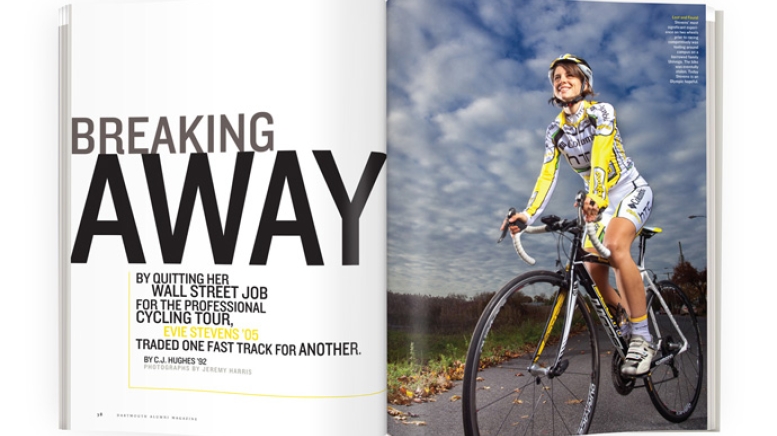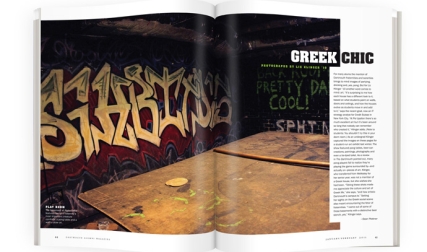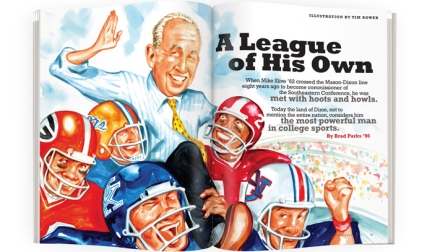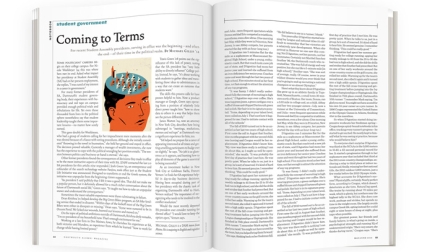At first blush little seems to distinguish Evie Stevens from any of the other bike riders whose spokes blur as they glide by stone walls and sheep on a warm fall morning on Cape Cod.
Although she blends into the crowd of stretchy outfits, Stevens, 27, is hardly a run-of-the-mill cyclist. In fact, she ranks among the fastest in the world.
She would much rather focus on how lucky she is to ride a bicycle for a living. “It’s just an incredibly liberating feeling,” she says, picking up speed on a downward slope, a breeze flattening some stray curls sticking out from beneath her helmet.
After working long hours for four years on Wall Street, when it was difficult to schedule even a daily run, Stevens decided in the late spring of 2009 to escape from the “win-win” corporate culture and pursue some victories of her own— on two wheels.
In what might seem an act of youthful folly Stevens abandoned her furniture on a Manhattan street corner, reduced her material possessions to what could fit in a couple of duffel bags and traded her cubicle for some cleats. With hardly any racing experience—Stevens had only a year’s worth of races under her belt—she was also forgoing a mezzanine fund associate’s six-figure salary to make in cycling what she might make as an administrative assistant. “I thought I would just sort of explore it, try it out for a year,” Stevens says, in a characteristic moment of self-effacement. “I’m still just learning the sport.”
She seems to be getting up to speed quickly. After a re-cent string of wins and lightning-quick times, the 5-foot-6-inch Acton, Massachusetts, native is poised to represent the United States at the 2012 Summer Olympics. “Sometimes I get very, very lucky in life. I don’t know why,” she says. “Things just align very nicely.”
Athletes do not achieve what Stevens has by sheer serendiptiy, however. Since June 2008—when she entered her first hard-surface race, a three-looper in Central Park—she has posted 20 first-place finishes in 70 USA Cycling-sanctioned events. All told, she has crossed the finish line in one of the top-three spots in more than half of her races.
Although some of those contests may have been small-potatoes events, most, such as last March’s Redlands Bicycle Classic in California, attracted a nerve-racking level of competition. Stevens earned a blue ribbon in the long-form road-race portion of the event, doing the 67 miles in 3 hours and 10 minutes. She also took the top prize in the 35-kilometer (21.7-mile) sprint-like time trial at June’s national championships in Oregon, clocking a blistering 47 minutes and 38 seconds.
In Europe, too, where cycling is generally considered a much fiercer sport, Stevens holds up. In July 2010 she experienced perhaps her brightest moment, in the middle of the 10-day Giro d’Italia, one of the world’s most prestigious races. During that stage, against more than 100 women, Stevens broke away from the pack to win by a comfortable 42 seconds for her HTC-Columbia team, which is among the best in the world. She finished 15th overall.
As a result Stevens is ranked 21st out of 360 women by the Union Cycliste International, the global governing group, and might well be even higher had she competed in more European races. Even so, her meteoric rise on the world stage compares to making baseball’s all-star team just three years after picking up a bat for the first time.
One can’t help but wonder where Stevens might rate had she fared better in the September world championships in Australia. She crashed during warm-ups when her bike skidded out on a wet patch of pavement while cruising along at the speed of a slow car. The wipeout scraped her hands so badly that two pink scars, on a left knuckle and between right-hand fingers, were clearly visible almost two weeks after the accident. “It was quite stupid,” Stevens says, “but it happened. And I learned my lesson.”
Stevens is not the first cyclist to take the sport by surprise. Every few years a runner or skier or even volleyball player in his or her mid-20s buys a bike and becomes a “second sporter,” according to Jim Miller, a vice president of USA Cycling, the sport’s governing body in the United States. “And when you find them, it’s fantastic and makes your day.”
An aura of mystery has surrounded Stevens from the start, says Patrick Littlefield, who in 2007 recruited her to her first team, the amateur New York squad Century Road Club Association/Avenue A Razorfish. “I kept hearing about this girl who was so strong and so good and how I had to put her on the team,” says Littlefield, 43, who like many Manhattan cyclists works in finance for a regular paycheck rather than racing full time as Stevens does.
Heightening the curiosity were claims that Stevens had cruised up a well-known, super-steep road along New Jersey’s Palisades cliffs in under six minutes, which is rare for anybody but especially for women, Littlefield says. (His best time is 6 minutes and 20 seconds.) “If a woman who has never raced before can do River Road that fast, there’s something going on,” Littlefield says. A meet and greet with the team in Brooklyn’s Prospect Park followed Stevens’ impressive Palisades sprint, and her career was launched.
Yet fans of the sport were mystified a novice could accomplish so much so fast. On September 1, 2008, at Vermont’s Green Mountain Stage Race, in a stage that coaches, organizers and fans can recall with great detail, Stevens started out with the slower Category 3 and 4 riders but somehow managed to catch the swifter Category 1 and 2 riders, despite the faster group getting a usually insurmountable five-minute head start. And, as the story goes, the hare caught the tortoise using laughably amateurish equipment.
“It became like a folk legend, about how she won her own race and passed the other race briefly, too,” says Michael Green, president of the Century Road Club Association, a New York race organizer. That Vermont mind-blower seemed to single-handedly elevate Stevens’ rank from Category 3 to 1 in just a few months. “Most racers never get to Category 1,” Green explains, “or it takes them at least a few years.”
Apparently, not everyone was aware of her rapid rise. Last year when Stevens rocketed across the finish line at the Valley of the Sun in Phoenix, Arizona, on the second day of a three-stage race, the official cameramen missed her entirely because “she was so unknown,” Green says. “They were getting ready to film somebody a minute behind her.”
Surprise can cut both ways, and there was initial scuttlebutt, motivated by jealous rivals perhaps, that performance-enhancing drugs might be behind Stevens’ strong debut. Fueling that speculation, no doubt, are continuing revelations about pro-cycling doping scandals in general. Stevens and all those who know her find those suggestions absurd. “I can’t think of anyone less likely to dope,” says close friend Ann Scott ’06. “Her body is like a temple, and she is so cautious about what she puts in it.”
Indeed, during sophomore summer, Stevens, a Kappa Kappa Gamma, was disqualified from an inter-sorority pong tournament because she wouldn’t drink her beer. “It was never really my thing,” she explains.
Though her success can seem accidental, Stevens, one of five siblings who played sports of one kind or another, was notably dexterous from a young age, according to oldest sister Angela, 42, a physical therapist in San Francisco. In fact, when her next-to-youngest sibling was 5, Angela says, Evie’s version of jump rope involved her bouncing atop a ball through a swinging hula hoop. “She was definitely coordinated and picked up things easily,” adds Angela.
It also emerged early on that Stevens needed to feel outgunned to kick into gear. As a freshman at Acton Boxborough Regional High School Stevens earned a spot on the varsity tennis team despite having almost no prior experience, says coach Mike Gardner. “She could barely get the ball back, but she got it back,” Gardner says. “She was not the fastest kid or strongest kid, but she just had this tremendous desire.”
A blunt college counselor would later use a line graph to convince Stevens that she had no shot at Dartmouth, but she was recruited for tennis and gained early admission. Though Stevens rode the bench most of the time, she stayed with the team until senior year, she says, “because I don’t like quitting.”
A government major with a minor in women’s and gender studies, Stevens stumbled during phone interviews for management consulting positions, she says, making her worry about finding a good job after graduation. One self-taught crash course in finance later, however, Stevens had scored a lucrative offer from Lehman Brothers, even if other analysts hired boasted considerably more accounting know-how. “I was a little in over my head to say the least,” says Stevens, although she seemed to catch on quickly. She landed a job at what was then the Gleacher Mezzanine Fund before Lehman imploded in 2008.
Even her first real attempt at a thigh-burning bike ride, on a California vacation to visit Angela, could be seen as an attempt to prove naysayers wrong. Zigzagging up and down Mount Tam, outside San Francisco, on Thanksgiving Day in 2007 Evie was feeling pretty good about keeping pace with her sister, a sometime racer, until they stopped. Angela “looked at me and said, ‘Normally, I go a lot harder than that,’ ” Evie recalls, laughing.
Female cyclists live fairly modest existences. Stevens declines to state her current income, but race organizers estimate that a sponsored racer of her caliber makes around $30,000 a year—a fraction of what Wall Street was paying. Although professional cyclists draw salaries from their corporate-sponsored teams and then share prize money awarded by events among team members, even the top male riders fall far short of earnings in the more publicized team sports.
Since quitting New York for cycling, Stevens has led a nomadic life. When she’s on the road, which is much of the time between March and October, she’s often bunking with other racers (which has made noise-canceling headphones critical). An apartment in Girona, Spain, provides a temporary base during swings through Europe (where her time is limited by lack of a visa), but stateside home is a rotation of beds, couches and inflatable mattresses in the apartments of fellow bikers or friends. She also takes extended pit stops at her parents’ new home in Dennis, Massachusetts.
If she has any regrets about trading New York’s riches for a more frugal existence, Stevens doesn’t show it. “She is really just having the time of her life,” says Scott. When pressed, Stevens cops to having socked away some money from her Wall Street days, lest her career take an unexpected turn. B-school is not out of the question in the future, she hints.
Her life isn’t all about gears and chains, either. On a recent return to New York after the racing season ended Stevens got to check out some Rothko paintings at the Museum of Modern Art. Another afternoon involved nothing more complicated than a park bench and some people-watching. The peripatetic quality of her new life means there’s little time for relationships, she says, though her friends seem to get it. “They have a great understanding of my off-the-grid nature,” Stevens says.
As a private person in this age of YouTube, Facebook and “over sharing” in general, Stevens has mixed feelings about her new celebrity, but she does want to draw attention to her sport. Aside from competition, Stevens wants to get more people biking in general—for exercise and as “a way to explore the outdoors.” If recreational bikers turn serious, that works, too: “No matter what level, in my opinion cycling is always fun,” she says. She’s also promoting the message of Transportation Alternatives, a New York group working to add more bike lanes to the street grid. Celebrities such as David Byrne and Matthew Modine have lent support; Stevens is one of the first athletes to join them. That adds an “important gender dimension” to getting more people pedaling, says executive director Paul Steely White. “People often think of [New York City] cyclists as 22-year-old male bike messengers, and we want to change that.”
Some cycling observers hope the hoopla surrounding her achievements doesn’t distract Stevens too much from her training. “The biggest danger would be for her to sense she’s already arrived,” says John Eustice, a former pro rider who’s now a race organizer and commentator with ESPN. “I don’t care how much talent you have, it takes a lot of time to become a champion.”
Coach Matthew Koschara, a former pro cyclist who’s been advising Stevens since meeting her in September 2008, agrees that focus is critical, but he sees greater risk in overtraining than slacking off. That’s why he’s careful to remind his dedicated tutee, in daily phone calls or e-mails during the season, to log no more than 30 hours a week on a bike of some type—just the thought of which might be enough to make most people clutch their chests in pain. He’s also sort of a diet counselor, regularly advising Stevens on meal plans that call for bananas before her pre-breakfast workout and maybe plain yogurt with honey afterward.
Koschara believes that Stevens’ newcomer status is an asset. “When you have the experience that Evelyn has in big business, you can deal with setbacks,” he says. “It’s also made her good at critical thinking.”
For someone in a sport that requires back-breaking amounts of exertion, Stevens can seem incredibly relaxed. On that recent ride on the Cape, without the pressures of a stopwatch, Stevens barely flinches as a silver-haired man politely announces he is about to pass. It is hard to imagine her that passive in race mode or in the peloton. Despite the tranquility of the scene, or perhaps because it allows her a flash of perspective on a lifestyle that seems planets apart from many of her fellow graduates, Stevens says she knows now that cycling is a perfect match for her personality.
“I don’t do things very casually,” she says. “I wish I could be a more balanced person, but usually if I get into something, I get really into it.”
C.J. Hughes is a freelance journalist. He lives in New York City.




